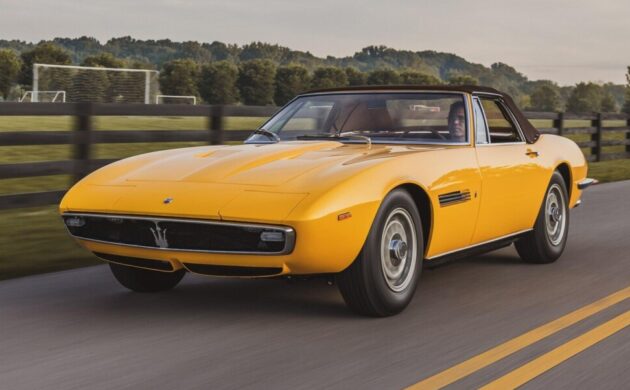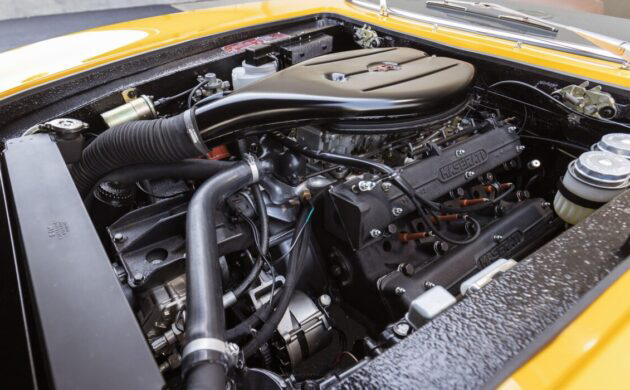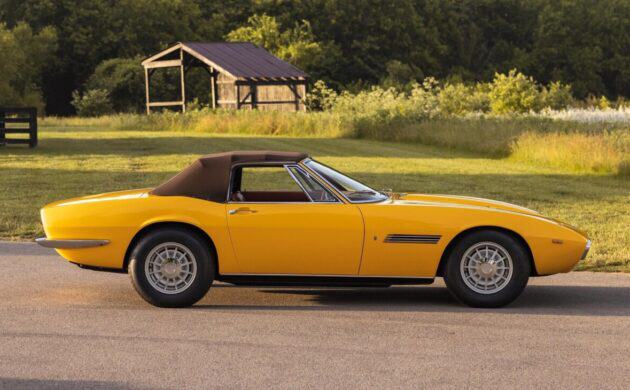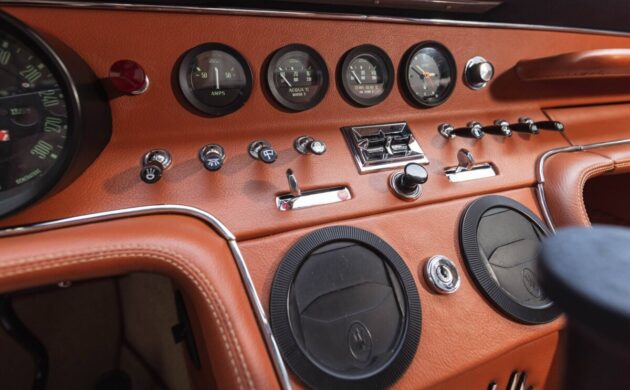Piercing the air with the authority and nobility of the trident spear in its grille, this 1968 Maserati Ghibli Spyder began life in the public eye as a prototype at the Turin, Italy car show. An exhaustive restoration returned the sypder, chassis number 1001, to new or better condition in 2018, at a cost of more than $422,000. Consigned to RM Sotheby’s, this top shelf classic heads to auction on 19 August 2022 in Monterey, California. Pack the big check book; the immaculate yellow Ghibli could bring $1,250,000 – $1,600,000 USD. Thanks to reader Araknid78 for the tip on this gorgeous Italian supermodel.
The 4.7L (287 cid) DOHC V8 makes 310 HP. Production models did not show this prototype’s never-utilized provision for dual spark plugs. Form may follow function, but what engine of the era displays a more beautiful rendering of its practical purpose? Thanks to RM Sotheby for some details.
The low-slung spyder (convertible) came to America in the 1970s, and comes with full documentation. Stored from 1986 until 2013, the former show car returned to public accolades after a mostly mechanical refurbishment.
The later restoration spared nothing, replacing a well-kept original interior with new leather cut from six hides.
In profile, the Ghibli shows off its tarmac-skimming chassis and lines penned by design house Ghia’s resident genius, Giorgetto Giugiaro. Understated yet forceful, every line shows stylistic intent. Every detail earns its keep. The rear wheel opening visually supports the rear portion of the canvas top like a graceful arched bridge. Black rocker panels accentuate the svelte low-flying body. This is what sports car fans everywhere try to achieve with classroom scribbles in ruled notebooks. Here we see the real thing, not only imagined on paper, but built and powered and ready to drive down the road.
Elegant switch gear and no-nonsense instruments serve the pilot of this road-going masterpiece, with the clock positioned furthest away. Time is irrelevant when you’re enjoying such a machine. Where did Ghia hide the radio? The DOHC V8 makes all the music most enthusiasts require. Where does this Ghibli rank on your list of classics worth more than a million?








Wow
just, wow
Convert to electric.
Stunning and historically significant, this will, no doubt, be a treasured piece in a well-heeled collector’s collection. To my eyes, though, the spyder is much less distinctive and seductive than the coupe. In that profile shot, it looks like a C3 Corvette that went to finishing school.
What most that see a Ghibli in photos will not realize is how big they really are. I had a chance to purchase on of the very rare Apox. 125 Ghibli convertibles that were ever made. Had an engine fire and needed to be rewired and painted but it was complete. Much larger than a corvette and almost Mustang size.
Comfortable, OH yes, Beautiful enough to melt your heart and devour your pocket book. I was lucky in a way someone got there first with the cash. Oh well at least I had the chance. But in the end I am glad I did not. Restoring it would not have phased me at the time but I think the ownership would. There are some things that are just so beautiful they need to be kept by someone that can afford to care for them long term. At the time I was a university student.
I made my way thru school by restoring english cars replacing wiring that had gone bad and this Ghibli would not have been that much harder. But I did not have the cash to support a Maserati habit. I did that later with a series II Sebring.
In 1975 I had the chance to buy the Paris Motor Show Ghibli Spyder for $6,000..perfect condition with, what seemed like, a burnt exhaust valve. I was even given the car to drive for the day.Crying in my morning coffee now…
I feel your pain brother. In 1983 I was coming back from Stuttgart the back way and drove past 1968 GHIBILI hardtop in very solid and good condition. The Ask was 25K DM or roughly $8,000 USD. My wife said no. My idiotic self didn’t buy it anyway. Can’t touch the same car for less than 70K last time I checked.
But this one is the holy grail. I would sell every family member I have and probably some of yours to buy that car. WOW. They say nothing is perfect, They have not seen this car.
Sweet!! No photos with the top down.
To repeat, why is this on Barn Finds?
Because it is an interesting, rare, beautiful car. We get a little history lesson.
Get over the name.
how hard must it have been to find those plastic dash vents and other bits of the interior? Interior is stunning !!!
No exterior door mirror, no a/c, & no radio – i guess it was never meant to be sold to a private party?
1st car i ever seen that has side marker lights on the fenders, but not on the quarter panels.
With that engine who needs a radio?
LOL what? Perhaps you shoul get out more.
I used to own a 1968 model year car without sideview mirrors, aircon, or radio. Quite common at the time (sideview mirrors and radios almost always aftermarket or dealer-installed items in this class of car, anyway).
Of course this car has air conditioning, as clearly shown in the photos.
If you’ve never seen a car with lights on the (front) fenders and not on the (rear) quarter panels, you could visit Europe anytime since ~1970, or look at photos of cars on the internet–most western European jurisdictions have required a turn signal repeater on the fender, but NOT required USA-style corner marker lights/retroreflectors at all four corners.
The car has AC you can see the compressor in the engine shot. It sits right in front of the alternator.
It was common to not to have exterior mirrors off during this time period, and for a long time you only got one on the drivers side. If you want bad look at an early Countach.
It has a place for the radio, it sits right below the AC vents, but in truth you couldn’t hear it that well anyway.
Lots of cars did not have side maker lights at this time. Alfa’s, Lancia’s, Aston and Jaguar’s definitely did not have side marker lights, basically anything euro or Japanese. Cars sold in the US were required to have them after about 1968. You will frequently see when these older euro cars are restored they are restored to Euro standards, where the side markers (Particularly the rear) are removed and the rear turn signals are changed to amber. Is this a good idea, well it does look cleaner, but you are definitely sacrificing some visibility.
The Ghibi is one of my absolute favorites, especially amongst the late 60’s and 70’s Italian makers. What a gorgeous profile and 3/4 views. Fun fact, Giorgetto Giugiaro also penned the Saab 9000…which is why *I* think it’s one of the most handsomely designed sedan/combis of the late 80’s and 90’s
But will it do 185 ?
I am aware many overseas cars have only a side marker light on each front fender , but it is always on the fender between the door & wheel.
This Ghibli is the 1st time i seen one on the extreme front fender & none on the rear qtr panel.
Oddly, only for ’68, Ford had reflective rear side markers that did not light up – stingy with the wiring? lol
I am pretty sure that a driver’s door mirror was required on USA cars at least as early in 1967. Very dangerous IMO to drive w/o one!
2 just-as-attractive-as-the-Ghibli USA prototypes that should have gone into production were the
https://www.carstyling.ru/en/car/1963_ford_cougar_ii/
& the
https://www.carstyling.ru/en/car/1966_pontiac_banshee_xp_798/
Oops – i meant this banshee …
https://www.carstyling.ru/en/car/1964_pontiac_banshee_xp_833/
The lamps you see between door and wheel on post-’71(?) European market cars are turn signal repeaters, not marker lamps. And I guess we don’t know if what we’re seeing here is a signal (I’m pretty sure the eventual regulations would require that it be aft of the wheel on a car of this length) or a marker lamp, but some jurisdictions (Italy only??) seemingly did, in fact, require a front corner marker lamp in the ’60s, but without the retroreflector requirement that the USA would introduce (at all four corners) in 1968. (In fact, it skipped my mind earlier, but my ’68 model year car that I mentioned in my earlier comment–the one without factory sideview mirrors, radio, or aircon–also had simple [non-reflective] corner marker lamps in the front fenders. And it was also an Italian-market car, for what that’s worth.)
I’m not familiar with ’68 Fords, but USA regs at the time would have required a corner marker lamp + retroreflector visible from the side at all four corners–were the taillamps sufficiently visible from the side, perhaps? (Or did Ford perhaps assert that the taillamps were sufficiently visible from the side for ’68, but NHTSA disagreed and required a lamp added to the rear fender for ’69?) Normally, if a lamp assembly wraps sufficiently around the corner of the car, manufacturers just add a retroreflector to the existing lamp assembly for the USA version but, IIRC, the first version of the new Mini took the (’68 Ford) approach that you describe above, on all four corners, with simple non-illuminated reflectors added to the USA-spec fenders, as the existing front/rear lamp assemblies must have been sufficiently visible from the sides.
Unlike those on the ’68’s & ’69s, the front side marker lights on the 2nd gen camaro & firebird(& probably many other GM cars of the ’70s) were not only a marker light(at night with the parking or headlites on) but were also blinkers – even in the daytime!! – a good idea! The front side markers also blink with the hazard lights on.
I do NOT like many “modern cars” incorporating the front blinkers & side marker lights together with the headlites in 1 assembly – makes them harder to see when blinking, IMO. I prefer that they be SEPARATE & as far away from the headlites as possible.
$995,000 USD | Sold